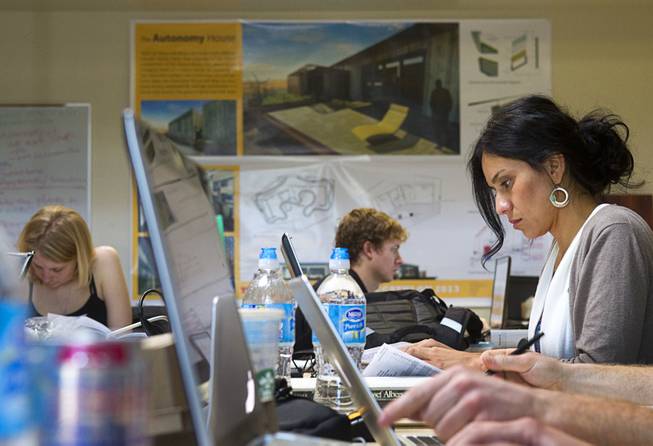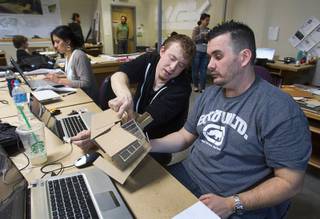
Danithza Olsen, a member of the UNLV Solar Decathlon team, reviews specs for building materials at the School of Architecture at UNLV Wednesday, Feb. 6, 2013. The solar decathlon is a biennial U.S. Department of Energy-sponsored competition intended to educate the public about energy-saving residential design. UNLV will compete against 19 other schools this October in Irvine, Calif.
Thursday, Feb. 14, 2013 | 2 a.m.
To donate:
For more information and to donate to the project, visit the Desert Sol website.
After more than a year of design drafts, a group of bright UNLV students is ready to break ground on a fully functioning house powered exclusively by the sun.
In January 2012, UNLV was selected to participate in the Solar Decathlon, a biennial competition that challenges 20 collegiate teams from around the world to design and construct a solar-powered house.
It's a pertinent challenge for a desert city like Las Vegas, where sunshine is abundant, natural energy resources are scarce and smog checks and air-quality warnings are ubiquitous. Armed with a $100,000 Department of Energy grant, UNLV's team hopes to build a "net-zero" energy building that will become the future of housing in Las Vegas.
The city already boasts a number of LEED-certified buildings — such as CityCenter — which use florescent light bulbs, motion sensors and tinted windows among other devices to cut down on energy use and costs.
Net-zero buildings are those that don't use fossil fuels, and therefore don't produce any carbon emissions. These buildings aren't just energy-efficient; they are designed to produce more energy than they consume.
It's an idea that is slowly gaining traction across the nation, especially in Southern Nevada, where solar companies have benefited from federal green-energy subsidies.
In December, the Las Vegas Cyclery, 10575 Discovery Drive, celebrated the opening of what is likely the first net-zero business in the city. The nearly 10,000-square-foot bike shop in Summerlin uses more than 200 solar panels to power its operations and sends electricity back into the NV Energy grid every month.
UNLV's solar house — a 735-square-foot vacation home — is expected to generate more electricity than it consumes when it's completed by the end of this summer. The home's 30 solar panels will generate 7.5 kilowatts of electricity every day, enough energy to power the house's LED lighting and heating and cooling systems, as well as its all-electric array of appliances.
It might not sound like much, but Team Las Vegas is pioneering what could become the prototype for a new breed of small, energy-efficient and energy-producing homes in Las Vegas.
"It's a fairly small project, but it's revolutionary," said Eric Weber, a UNLV architecture professor who is overseeing the “Desert Sol” project. "You don't necessarily need a 3,500-square-foot house in Las Vegas. We need better-designed homes and a more sustainable way of living in the desert."
Weber points to the stucco and clay homes that are popular across the Sun Belt. These materials absorb and trap heat, creating "urban heat islands" that push up the mercury, even at night, Weber said.
That's why Team Las Vegas decided to use a steel roof for its solar house, because metal is a quick conductor of heat and cold. It's one of the many design details developed over the past year by nearly 80 undergraduate and graduate students working on the interdisciplinary project.
Desert Sol incorporates design elements and desert plants native to the Mojave Desert.
The exterior uses weathered wood and steel in an homage to Nevada's abandoned mining towns. A metal shade structure on the southwest side of the house — where the afternoon sun will be the harshest — will have an imprint of mesquite tree. Central to the house will be a shaded fountain that uses recycled rainwater, a nod to the Las Vegas oasis.
Inside, the house boasts a finished wood and glass look, complete with a kitchen, bathroom, living room area, closet space and bedroom. There is a utilitarian functionality about the place, from a television that stows away inside of a wall to a couch that doubles as a second bed.
"It's a small house, but we're all putting in a lot of effort," engineering student Jinger Zeng said. "Our love density is really high."
Once the final designs are approved, Team Las Vegas is expected to begin building its model house by the end of this month. Students will complete the majority of the construction, with assistance from certified welders, plumbers and electricians. The entire project – from blueprint to finished product – is expected to cost about $800,000, the majority of it coming from donations.
The house will be built on two rolling mobile home chassis, and then driven from the construction site on UNLV's Paradise campus to the competition site in Irvine, Calif., where the house must be reassembled.
It's much like a cake competition where chefs create elaborate pastries that have to be moved from the prep table to the competition table. Much can go wrong during the build-out, transportation and reassembly. That's why the team has been conscientious in its preparation, planning out every last detail, including safe highway routes.
"Most class projects have us draw a few details and a floor plan," architecture student Alexia Chen said. "With this, we have to design every aspect of the house. It's a special experience."
Once in California, Team Las Vegas will participate in a number of competitive events that showcase the home. Desert Sol will be the site of several gatherings, including a dinner party for four people as well as a movie night.
"We're from Las Vegas, the entertainment capital of the world, so we have to win this," Chen said, smiling.
After the competition, the house is expected to return to Las Vegas, where it may find a permanent home in a museum exhibit, Weber said. If it's successful, a home manufacturer could pick up UNLV's solar home design for mass production — that's what happened to Appalachian State University's design in 2011.
Whatever becomes of the project — whether it wins the competition or becomes the model for future homes in Las Vegas — Weber is excited for the opportunity it is providing UNLV and its students. The vast majority of Solar Decathlon graduates end up in lucrative green-energy fields, he said.
UNLV's designs have done well in preliminary reviews against heavyweight contenders like Stanford and Cal Tech.
"It's always the most exciting part to see these dreams become reality," Weber said of the project's impending groundbreaking. "There are exceptional people doing really good work all across this campus. We want to demonstrate to the community what we're capable of."


Join the Discussion:
Check this out for a full explanation of our conversion to the LiveFyre commenting system and instructions on how to sign up for an account.
Full comments policy